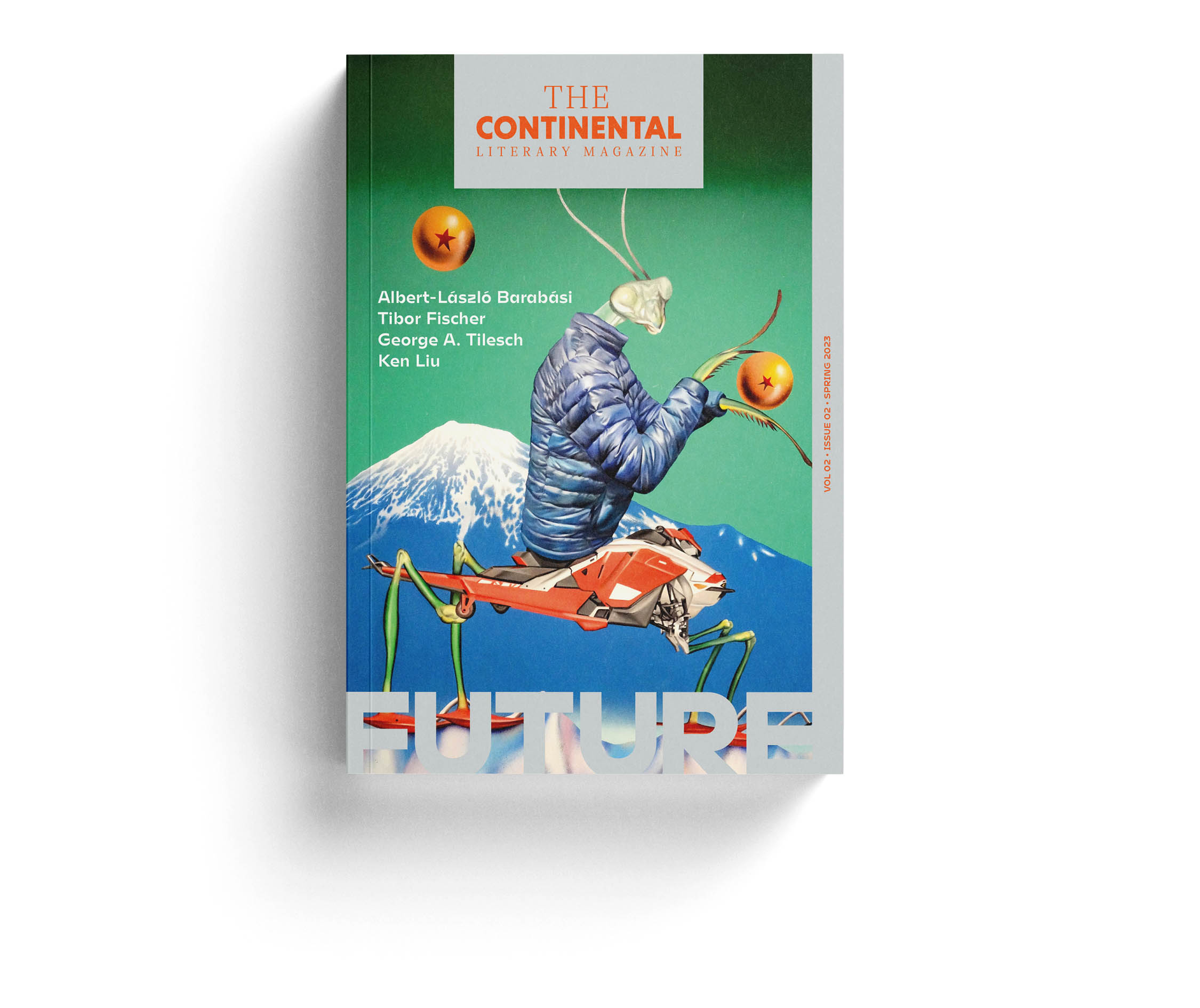
31st May 2023
Fiction
7 minutes read
Rug in the Trunk
translated by Thomas Cooper

31st May 2023
7 minutes read
On an early spring day, Monday 13 March 1961, the Austrian Minister of Agriculture in Klosterneuburg presented the gold medal for the best white wine from Lower Austria in 1960 to Mrs. Theresia Kargl for her carefully selected Grüner Veltliner from the granite slopes of Dürnstein. On the same day, in the presence of the mayor of Vienna, the Swedish machine which had been in use for a good 15 years on the Franz Joseph Quay (which was particularly rich with ruins), grinding the debris from the war into powder and then pressing it into brand new bricks for construction, was ceremoniously disassembled.
“The city of Vienna,” the mayor declared, “has finally run out of the sad relics of a senseless war.”
On the same day, a Volga M-21 car with a Hungarian license plate passed through the Wolfsthal border station into Czechoslovakia and then, trundling down the left bank of the Danube, crossed the Komárom bridge and reached the territory of the Hungarian People’s Republic. At the same hour, as had been agreed days earlier, an American and a French acquaintance were waiting for Anzelm Komjáthy, a Hungarian-born chemical engineer living in Vienna who was famous for his punctuality and reliability. They waited, however, in vain. First, they tried to call Komjáthy’s apartment from the telephone in the Sperl café, but without success. Then, suspecting foul play, they called the police.
The police broke down the door to the apartment on the second floor of the building at Ottakringer Strasse 140 (on the ground floor of which the Gissinger butcher’s shop sells very high-quality ham). The flat had been ransacked: loose change, bed sheets, clothes, documents, and photographs were strewn all over the bare floor. It soon became clear that the floor had not always been bare. The American acquaintance, who asked that neither his name nor his profession be mentioned, had been to Komjáthy’s apartment several times, and he clearly remembered the large hand-woven Persian rug, about four by three meters, which almost shimmered with various shades of yellow, red, brown, and purple and which was now conspicuously absent from the living room. Komjáthy, the American acquaintance noted, had bought it at an auction once when he had happened to have plenty of money, and he had been quite proud of his acquisition.
A kidnapping in the Austrian capital! Just six years after the Soviet troops had withdrawn! Barely a few months before Khrushchev and Kennedy would hold a summit meeting in Vienna, during which the idea would be taking shape in the bald head of the General Secretary of the Central Committee of the Soviet Communist Party of building a wall around West Berlin to prevent the mass flight of GDR citizens to the West. And just a few weeks before an ordinary Soviet man would step out into the universe in the Vostok-1 space capsule, or at least would skim the stratosphere and fly almost completely around the earth.
There were indeed signs of a struggle in the apartment and even traces of blood. From these traces, it was learned that the injured person was blood type O, and according to the medical records, Komjáthy was blood type O. The forensic experts also found a lock of hair which had been torn from the victim’s scalp. The hairs were a perfect match, both in color, length, and microstructure, with the hairs found in the hairbrush in the bathroom. A woolen handkerchief was also found, which chemical analysis revealed to have been soaked with trichloromethane, also known as chloroform, during the early morning hours, as was a hypodermic needle and an empty ampule (Midazolam, 10 millilitres). These items of evidence could be linked to the cognac bottle (German brand, Asbach Uralt) found in the living room, which was only half empty. It could be assumed that the perpetrators had forced Komjáthy to drink from the bottle (although none of the witnesses who were interrogated had ever seen him drunk) or, which seems more likely, that one of the perpetrators had consumed the German brandy, pretended to be drunk, and asked for help, and when Komjáthy had bent over him, the other perpetrator had knocked him down and used the chloroform to knock him out.
When chloroform is administered in small amounts, the effects only last for a short time, but in larger amounts, it can cause paralysis of the heart.
It is thus possible that the perpetrators first knocked Komjáthy down and then knocked him unconscious with small amounts of chloroform, and then, taking advantage of the fact that he was in a daze for a few minutes, they injected him with a sedative, probably in his thigh.
The neighbors who were interviewed had heard some noises in the early morning hours, but they had found nothing unusual about this, as they had often heard someone pacing or moving chairs around or other, similar sounds from Komjáthy’s apartment. They had even mentioned the issue to the superintendent of the building, but no action had been taken.
One of the residents, a hotel concierge by profession, said that he had arrived home at around 4:00 am that day and had seen three men from across the street coming out of the gate of the building carrying a long, heavy object. One doesn’t have to be a prophet to figure out that this must have been the missing Persian rug, rolled up and weighed down by the living (or dead) body of Anzelm Komjáthy. A Volga with Hungarian plates obviously would have attracted attention in Vienna, so the perpetrators had taken the unconscious Komjáthy in a car with Viennese plates to Hainburg, where the Volga had been waiting for them on the side of the road. One of the perpetrators had then returned to Vienna in the Austrian vehicle, and the Czechoslovak comrades, who had been properly informed, had opened the border crossing for the gray Volga.
It is worth noting, in connection with the case, that in the course of a thorough search of the apartment the electrician found a camera in the chandelier. There was no film inside. Someone had clearly taken it out. But why had he left the little device there?
The Austrian Minister of Interior launched a nationwide search for an unknown perpetrator.
The Foreign Minister summoned the Hungarian ambassador in Vienna. He gave voice to his suspicion that officials from the Hungarian Ministry of Interior were behind the kidnapping. He pointed out to the ambassador that Komjáthy had been an Austrian citizen since 1951, and that the kidnapping was therefore not simply a violation of human rights but also a violation of Austria’s sovereignty. He pointed out that the incident might well harm Austrian-Hungarian relations, which were just beginning to improve. More specifically, it could hamper the planned purchase by Austria of the Trautson Palace, which was in a dilapidated state (and was still owned by the Hungarian state).
After all this, again no action was taken.
The hero of our story was the grandson of the nineteenth-century symbolist poet Jenő Komjáthy. For this reason alone, he was held to be a man of culture and learning. Quality is inherited, he often said. He had been raised in a good bourgeois household and learned German, English, French, and Italian as a child. His father, Győző Komjáthy, who had been the director of the Pest equestrian racecourse before the war, had provided generous support for his son and had enabled him to travel to Austria, Switzerland, and northern Italy in the mid-1930s. After the eighteen months of wanderings had come to an end, he had continued to provide support for his son, and Anzelm had pursued studies both at the Faculty of Law at the Péter Pázmány University and at the Faculty of Chemical Engineering at the University of Technology.
Shortly after receiving his two degrees, Anzelm got married.







